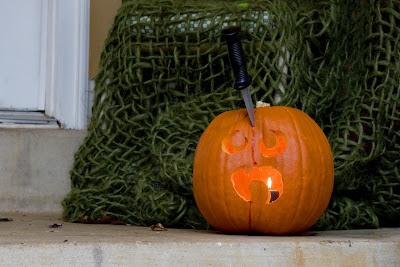We've kept such busy lives the past few years, though, that even during our rental home years in Vienna, we didn't get to indulge in sculpting melons into creatures of horror and whimsy. This year, hurried and hectic as it's been, we managed to put together a couple of pumpkins, though--I made a point last weekend of picking several up at Safeway and Sam's Club:
 I'm not sure quite where I got the original idea for poor Peter Pumpkinhead here and his grisly demise. I think I'd just read through the latest set of hung-over pumpkins making the e-mail rounds (a creative use of pumpkin innards, I must admit, if one that gets recycled each year), and maybe thought back to the scene in It's the Great Pumpkin, Charlie Brown! where Linus bemoans Lucy "killing" the pumpkin with her incision. There's probably even a bit of Calvin and Hobbes' demented snowmen in him.
I'm not sure quite where I got the original idea for poor Peter Pumpkinhead here and his grisly demise. I think I'd just read through the latest set of hung-over pumpkins making the e-mail rounds (a creative use of pumpkin innards, I must admit, if one that gets recycled each year), and maybe thought back to the scene in It's the Great Pumpkin, Charlie Brown! where Linus bemoans Lucy "killing" the pumpkin with her incision. There's probably even a bit of Calvin and Hobbes' demented snowmen in him.
 After crafting Peter's sorry, sordid tale of death by plastic knife misadventure, I tasked Beth with designing an evil, menacing pumpkin face. The result above does Jack O' the Lantern himself and his cursed fallen soul proud; I took her design and carved a few embellishments (like the slits in the eyes) and the row of gnashing teeth beneath his two vampiric fangs. I'm only surprised Mr. Jack didn't send a few more kids screaming in terror.
After crafting Peter's sorry, sordid tale of death by plastic knife misadventure, I tasked Beth with designing an evil, menacing pumpkin face. The result above does Jack O' the Lantern himself and his cursed fallen soul proud; I took her design and carved a few embellishments (like the slits in the eyes) and the row of gnashing teeth beneath his two vampiric fangs. I'm only surprised Mr. Jack didn't send a few more kids screaming in terror.
 Finally, I wanted to share an after-dark photo of Peter Pumpkinhead. Though in the shadows you can't see the blood running down his gourdy forehead, his tragic expression is rendered that much better.
Finally, I wanted to share an after-dark photo of Peter Pumpkinhead. Though in the shadows you can't see the blood running down his gourdy forehead, his tragic expression is rendered that much better.
 I'm not sure quite where I got the original idea for poor Peter Pumpkinhead here and his grisly demise. I think I'd just read through the latest set of hung-over pumpkins making the e-mail rounds (a creative use of pumpkin innards, I must admit, if one that gets recycled each year), and maybe thought back to the scene in It's the Great Pumpkin, Charlie Brown! where Linus bemoans Lucy "killing" the pumpkin with her incision. There's probably even a bit of Calvin and Hobbes' demented snowmen in him.
I'm not sure quite where I got the original idea for poor Peter Pumpkinhead here and his grisly demise. I think I'd just read through the latest set of hung-over pumpkins making the e-mail rounds (a creative use of pumpkin innards, I must admit, if one that gets recycled each year), and maybe thought back to the scene in It's the Great Pumpkin, Charlie Brown! where Linus bemoans Lucy "killing" the pumpkin with her incision. There's probably even a bit of Calvin and Hobbes' demented snowmen in him.But at any rate, Peter came out on the wrong end of some argument--perhaps King Eggplant came home and caught ol' Peter in bed with his wife the Summer Squash. That knife didn't just grow from Peter's forehead, though, and his expression of shock at the discovery quickly gave way to a fatal dismay. Poor Peter!
 After crafting Peter's sorry, sordid tale of death by plastic knife misadventure, I tasked Beth with designing an evil, menacing pumpkin face. The result above does Jack O' the Lantern himself and his cursed fallen soul proud; I took her design and carved a few embellishments (like the slits in the eyes) and the row of gnashing teeth beneath his two vampiric fangs. I'm only surprised Mr. Jack didn't send a few more kids screaming in terror.
After crafting Peter's sorry, sordid tale of death by plastic knife misadventure, I tasked Beth with designing an evil, menacing pumpkin face. The result above does Jack O' the Lantern himself and his cursed fallen soul proud; I took her design and carved a few embellishments (like the slits in the eyes) and the row of gnashing teeth beneath his two vampiric fangs. I'm only surprised Mr. Jack didn't send a few more kids screaming in terror. Finally, I wanted to share an after-dark photo of Peter Pumpkinhead. Though in the shadows you can't see the blood running down his gourdy forehead, his tragic expression is rendered that much better.
Finally, I wanted to share an after-dark photo of Peter Pumpkinhead. Though in the shadows you can't see the blood running down his gourdy forehead, his tragic expression is rendered that much better.A successful return of our pumpkin-carving traditions, wouldn't you say?




